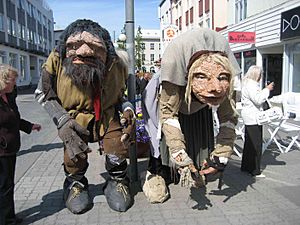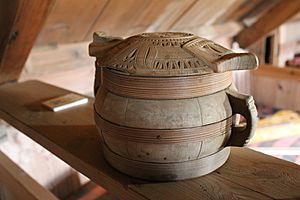Icelandic Christmas folklore facts for kids
Icelandic Christmas folklore tells us about special characters and monsters from the mountains. They visit towns during Christmas. These stories were first used to encourage children to behave well. The tales include funny pranksters who leave gifts. They also feature scary monsters who might eat naughty children.
These characters are said to live together in a cave. They are a family, and they include:
- Grýla is a huge giantess. She loves to cook and eat mischievous children. Her husband, Leppalúði, is quite lazy. He usually stays at home in their cave.
- The Yule Cat is a giant, mean cat. It roams the snowy countryside during Christmas time (Yule). It is said to eat people who haven't received new clothes before Christmas Eve.
- The Yule Lads are Grýla and Leppalúði's sons. There are 13 of them. They are playful tricksters who like to steal or bother people. Each one has a name that describes their favorite prank. They visit towns one by one during the 13 nights before Yule. They leave small gifts in shoes that children put on window sills. But if a child has been naughty, they leave a rotten potato instead.
These Christmas folk tales first appeared around the 1600s. They changed a bit depending on the region and how old the stories were. Today, these characters are often seen as more friendly.
Contents
History of Icelandic Christmas Tales
How the Stories Began
The first time the Yule Lads were mentioned was in a poem from the 1600s called Poem of Gryla. Grýla had been in older stories as a troll. But she wasn't linked to Christmas until this poem. The poem describes Grýla as a very ugly being. She is the mother of the huge Yule Lads. They were a threat to children.
At first, the number and look of the Yule Lads changed a lot. It depended on where you were in Iceland. Each Yule Lad could be just a prankster or a scary monster. They were used to make children behave. It was like the bogeyman in other cultures. The King of Denmark even disliked using them to discipline children.
In the late 1700s, another poem mentioned 13 Yule Lads. In the mid-1800s, a writer named Jón Árnason started collecting folk tales. He was inspired by the Brothers Grimm. His collection from 1862 was the first to name the Yule Lads.
In 1932, the poem "Yule Lads" became very popular. It was part of a book called Christmas is Coming (Jólin koma) by Jóhannes úr Kötlum. This poem set the standard for the 13 Yule Lads. It gave them their names and personalities that we know today.
Meet Grýla and Leppalúði

Grýla is a giantess. She was first mentioned in a 13th-century collection of Norse mythology called Prose Edda. But she wasn't connected to Christmas until the 1600s. She is enormous and looks very scary.
The oldest poems about Grýla say she was a beggar. She would go around asking parents for their naughty children. People could stop her by giving her food or chasing her away. She first lived in a small house. But later poems say she was forced out of town. She then lived in a faraway cave.
Today's Grýla can tell when children are misbehaving all year long. She comes down from the mountains at Christmas time. She searches nearby towns for her favorite meal. She leaves her cave, hunts for children, and carries them home in her giant sack. She loves to eat children as her favorite snack. Her most loved dish is a stew made of naughty kids. She can never get enough of it. Legend says there is always plenty of food for Grýla.
Folklore says Grýla has been married three times. Her third husband, Leppalúði, lives with her in their cave. It's in the Dimmuborgir lava fields. The big black Yule Cat and their sons also live there. Leppalúði is lazy. He mostly stays at home in their cave. Grýla supposedly has many other children from her past marriages. But they are rarely talked about now.
The Yule Cat
The Yule Cat, known as Jólakötturinn, is a huge and mean cat. It is said to lurk in the snowy countryside during Christmas. It eats people who have not received any new clothes before Christmas Eve. This cat is the pet of Grýla and her sons.
Even though it's called an old tradition, stories about the Yule Cat only appeared in writing around the 1800s. Farmers used the threat of the Yule Cat to make their workers finish processing autumn wool before Christmas. Workers who helped would get new clothes. But those who didn't would get nothing. They would then be hunted by the giant cat. The cat was also sometimes said to just eat the food of those without new clothes during Christmas feasts. The idea of the Yule Cat as a human-eating beast became popular partly because of poems by Jóhannes úr Kötlum, just like the other folklore.
The Yule Lads
The Yule Lads (sometimes called Yuletide-lads or Yulemen) are the sons of Grýla and Leppalúði. They are a group of 13 playful tricksters. They like to steal things or bother people. Each one has a name that describes their favorite way to cause trouble. They arrive one by one over the last 13 nights before Christmas (Yule). They leave small gifts in shoes that children put on window sills. But if a child has been naughty, they leave a rotten potato in the shoe instead.
Today, the Yule Lads are sometimes shown in a friendlier way. They are like Santa Claus and other gift-givers. They are usually shown wearing old Icelandic clothes. But sometimes they wear Santa Claus costumes, especially at children's events.
List of Yule Lads
The Yule Lads arrive during the 13 nights before Christmas. The first one comes on December 12. Then, one leaves each day starting on Christmas Day, in the same order they arrived. So, each Yule Lad stays for 13 days. Here are the 13 Yule Lads and when they arrive and leave:
| Icelandic name | English translation | Description | Arrival | Departure |
|---|---|---|---|---|
| Stekkjarstaur | Sheep-Cote Clod | Harasses sheep, but is impaired by his stiff peg-legs. | 12 December | 25 December |
| Giljagaur | Gully Gawk | Hides in gullies, waiting for an opportunity to sneak into the cowshed and steal milk. | 13 December | 26 December |
| Stúfur | Stubby | Abnormally short. Steals pans to eat the crust left on them. | 14 December | 27 December |
| Þvörusleikir | Spoon-Licker | Steals and licks wooden spoons. Is extremely thin due to malnutrition. | 15 December | 28 December |
| Pottaskefill | Pot-Scraper | Steals leftovers from pots | 16 December | 29 December |
| Askasleikir | Bowl-Licker | Hides under beds, waiting for someone to put down their askur (a type of bowl with a lid used instead of dishes), which he then steals. | 17 December | 30 December |
| Hurðaskellir | Door-Slammer | Likes to slam doors, especially during the night, waking people up | 18 December | 31 December |
| Skyrgámur | Skyr-Gobbler | Has a great affinity for skyr (similar to yogurt) | 19 December | 1 January |
| Bjúgnakrækir | Sausage-Swiper | Hides in the rafters and snatches sausages that are being smoked | 20 December | 2 January |
| Gluggagægir | Window-Peeper | A snoop who looks through windows in search of things to steal | 21 December | 3 January |
| Gáttaþefur | Doorway-Sniffer | Has an abnormally large nose and an acute sense of smell which he uses to locate leaf bread (laufabrauð) | 22 December | 4 January |
| Ketkrókur | Meat-Hook | Uses a hook to steal meat | 23 December | 5 January |
| Kertasníkir | Candle-Stealer | Follows children in order to steal their candles (which were once made of tallow and thus edible) | 24 December | 6 January |
The English names are from Hallberg Hallmundsson's translation of the poem.
Other Yule Lads Stories
Before these 13 Yule Lads became the most popular, their descriptions varied. Some were said to be Grýla's sons. Others were her brothers. Some stories only talked about nine Yule Lads. But each one had their own special prank.
Most of the different Yule Lads can be put into groups. Some steal food. Some like to play tricks or bother people. Others seem to be like parts of nature. For example, Gully Gawk just hides in gullies.
In the east of Iceland, there was a folk tale about a different group of Yule Lads. They came from the ocean, not the mountains. One very old nursery rhyme mentions two female Yule pranksters. They would steal melted fat. They would either stuff it up their noses or put it in socks.
Icelandic Folklore in Pop Culture
Grýla and the Yule Lads are main characters in a 2018 holiday episode of Chilling Adventures of Sabrina. The lads bother the household. Grýla tries to take a baby from Sabrina's aunt.
Extra Credits talks about Grýla, the Yule Lads, and the Yule Cat. This was in a 2019 episode of Extra Mythology.
The Yule Cat, named Jola, appears in the 2020 Netflix movie The Christmas Chronicles 2. Santa Claus chases Jola. Jola is friendly with the bad guys, Belsnickle and Speck. Belsnickle lets Jola loose in the reindeer stable, where he hurts Dasher. When Jack tries to get a root to help the Christmas elves, Jola attacks him. Jack fights him off with an explosive gingerbread cookie. Later in the movie, Dasher gets better and tackles Jola. Santa Claus then sends Jola flying out of Santa Village.
The Yule Lads are the main characters in an episode of the Netflix animated series Hilda. This was the tenth episode of the second season, aired in 2020. They are shown as Grýla's unwilling helpers. They look for naughty children for her stew. They are afraid she will cook them if they fail.
Spoonlicker appears in the Grant Morrison comic Klaus and the Witch of Winter.
The Yule Lads have been featured on the YouTube channel Drawfee. This happened in twelve episodes between 2018 and 2020. The artists were given a lad's name and a short description. Then they had to draw it.
The Yule Lads were also the topic of the 12th episode of the "Cox N' Crendor" podcast. This was released in 2013. The YouTube and comedian duo Jesse Cox and Crendor jokingly talked about the Yule Lads and their different pranks.
Grýla appears as a small villain in the 2022 game God of War Ragnarök.


